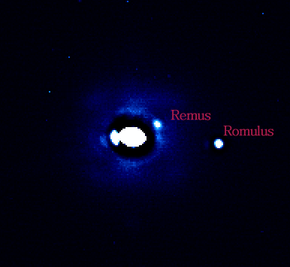 Adaptive Optics observations of (87) Sylvia, showing its two satellites, Remus and Romulus. | |
| Discovery[1] | |
|---|---|
| Discovered by | Franck Marchis, Pascal Descamps, Daniel Hestroffer, Jérôme Berthier |
| Discovery date | August 9, 2004 |
| Designations | |
| Sylvia II | |
| Pronunciation | /ˈriːməs/ |
Named after | Rēmus |
| S/2004 (87) 1 | |
| Main belt (Cybele) | |
| Adjectives | Remian /ˈriːmiən/[2] |
| Orbital characteristics[3] | |
| 706 ± 5 km | |
| Eccentricity | 0.016 ± 0.011 |
| 1.3788 ± 0.0007 d | |
Average orbital speed | 37.2 m/s |
| Inclination | 2.0 ± 1.0° (with respect to Sylvia equator) |
| Satellite of | 87 Sylvia |
| Physical characteristics | |
| Dimensions | 7 ± 2 km [3][a] |
| Mass | ~ 2×1014 kg (estimate)[b] |
Equatorial escape velocity | ~ 4 m/s (estimate) |
| unknown, probably synchronous[c] | |
| unknown, zero expected | |
| 11.1[3] | |
Remus is the inner and smaller moon of the main-belt asteroid 87 Sylvia. It follows an almost-circular and close-to-equatorial orbit around the parent asteroid. In this respect it is similar to the other Sylvian moon Romulus.
- ^ IAUC 8582, announcing the discovery of S/2004 (87) 1 and naming Romulus and Remus.
- ^ William Coe Collar (1891) The Gate to Caesar, p. 117
- ^ a b c F. Marchis; et al. (2005). "Discovery of the triple asteroidal system 87 Sylvia" (PDF). Nature. 436 (7052): 822–4. Bibcode:2005Natur.436..822M. doi:10.1038/nature04018. PMID 16094362. S2CID 4412813.
Cite error: There are <ref group=lower-alpha> tags or {{efn}} templates on this page, but the references will not show without a {{reflist|group=lower-alpha}} template or {{notelist}} template (see the help page).